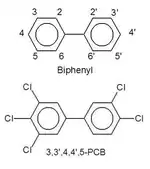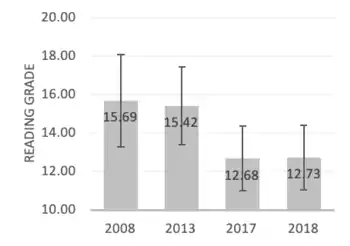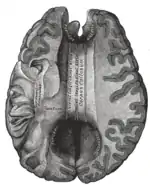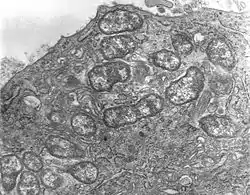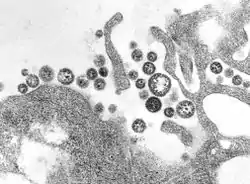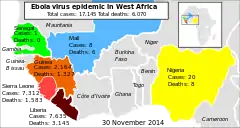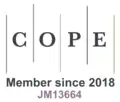WikiJournal of Medicine
Open access • Publication charge free • Public peer review • Wikipedia-integrated
|
VOLUME 6 (2019)
ISSUE 1
Previous issue
Author: Jouko Tuomisto
Dioxins and dioxin-like compounds comprise a group of chemicals including polychlorinated dibenzo-p-dioxins (PCDD) and polychlorinated dibenzofurans (PCDF), as well as certain dioxin-like polychlorinated biphenyls (dl-PCB), and potentially others. They act via a common mechanism, stimulation of aryl hydrocarbon receptor (AH receptor, AHR), a vital transcription factor in cells. There are very high differences in potency among these compounds, i.e. in the ability to stimulate the receptor. This leads to ten thousand fold or higher differences in doses causing similar toxic effects. Most of these compounds are eliminated very slowly in the environment, animals, or humans, which makes them persistent. They are much more soluble in fat than in water, and therefore they tend to accumulate in lipid or fatty tissues, and concentrate along the food web (bioaccumulation and biomagnification). Full text | Download doi: 10.15347/WJM/2019.008
Authors: James Heilman, Aleksandar Brezar
Objective: To assess and compare the readability of the twenty-five most accessed English medical articles on Wikipedia 0, 1, 5 and 10 years ago. Design: The twenty-five most accessed Wikipedia articles on diseases in August 2018 were identified for this study. The content of the lead paragraphs was formatted to remove any hyperlinks, decimals, colons, semicolons and periods used in abbreviations. An online tool was then used to assign a score to the readability of each text sample using the following formulae: Gunning FOG (Frequency of Gobbledygook) index, Flesch-Kincaid Grade Level (F-K), Simple Measure of Gobbledygook (SMOG) and Flesch Reading Ease (FRE). A single reading grade (RG) was calculated for each passage by averaging scores from the FOG, SMOG and F-K tests to facilitate interpretation. These steps were repeated for the lead paragraph of the same medical articles as visible 1, 5 and 10 years ago on Wikipedia. Main Outcome Measures: Readability grade (RG) and reading ease (FRE score) Full text | Download doi: 10.15347/WJM/2019.007
Authors: Gloria Likupe, Roger Watson, Salma Rehman
Aim: To evaluate the evidence published in systematic reviews on the effectiveness of interventions aimed at alleviating mealtime difficulties in older people with dementia. Background: Older people with dementia gradually lose their self-care abilities as the condition of dementia progresses and this includes the ability to eat independently. There is a large body of research into this phenomenon, including into the effectiveness of interventions to alleviate the problems which arise. Recently there have also been several systematic reviews with different conclusions about the effectiveness of these interventions. Design: A systematic review of systematic reviews. Methods: Databases MEDLINE, Cumulative Index to Nursing and Allied Health Literature (CINAHL), PsychINFO, Excerpta Medica Database (EMBASE), the Cochrane Library and the Joanna Briggs Library) were searched between January 2005-December 2018 using the search strategy: (feeding OR mealtimes OR eating OR intake OR food and drink OR nutrition OR difficulty) AND dementia AND intervention AND systematic review. The Critical Appraisal Skills Programme (CASP) checklist for Systematic Reviews was used to evaluate the reviews. Results: Eight eligible studies were retrieved; three scored 10 and five scored 8 according to the CASP checklist. Conclusion: The quality of the reviews included in the review were high. There is no strong evidence to support the use of any particular intervention for the alleviation of mealtime difficulties in older people with dementia. Methodological problems related to sample size and bias were apparent in the studies included in all the reviews and there was a lack of standardisation around interventions and outcomes across studies. Behavioural intervention, specifically Montessori education and spaced retrieval methods were considered promising and worthy of further research. Full text | Download doi: 10.15347/WJM/2019.006
Authors: Osmin Anis, et al. , et al.
Dyslexia is a neurodevelopmental disorder characterized by difficulty learning to read and spell. Underlying deficits typically include impaired phonological awareness (an awareness of the sound structure of words) and processing; difficulty with verbal working memory; and slow verbal processing speed. Observable problems include frequent spelling errors that same-age children do not exhibit; difficulty learning how to decode individual words, including "sounding out" words; and struggling to pronounce words correctly and fluently when reading aloud. Deficits in reading comprehension often occur as a secondary consequence. Dyslexia is a heterogeneous disorder, which means that not all people with dyslexia have the same signs, symptoms, underlying deficits, or functional impairment. Children and adults with dyslexia exhibit higher rates of comorbid conditions such as developmental language disorders; attention-deficit/hyperactivity disorder (ADHD); and difficulties with motor coordination, mental calculation, concentration, and personal organization, but these are not, by themselves, markers of dyslexia. Dyslexia manifests on a continuum of severity—it is a dimensional disorder. People with this disorder have a normal desire to learn. Full text | Download doi: 10.15347/WJM/2019.005
Authors: Kholhring Lalchhandama, et al. , et al.
Orientia tsutsugamushi is a mite-borne bacterium belonging to the family Rickettsiaceae and is responsible for the disease scrub typhus in humans. It is an obligate intracellular parasite of trombiculid mites, in which natural transmission is maintained from the female to its eggs (transovarial transmission) and from the eggs to adults (transstadial transmission). With a genome of only 2.0–2.7 Mb, it has the most repeated DNA sequences among bacteria. It is transmitted by mite larvae (chiggers) from rodents, the natural hosts of mites, to humans through accidental bites. Naosuke Hayashi first described it in 1920, giving it the name Theileria tsutsugamushi, but it was renamed to Orientia tsutsugamushi in 1995, owing to its unique properties. Unlike other Gram-negative bacteria, its cell wall lacks lipophosphoglycan and peptidoglycan. It instead has a unique 56-kDa type-specific antigen (TSA56), which gives rise to many strains (sub-types) of the bacterium such as Karp, Gilliam, Kato, Shimokoshi, Kuroki, and Kawasaki. It is most closely related to Candidatus Orientia chuto, a species described in 2010. Primarily indicated by undifferentiated febrile illnesses, the infection can be complicated and often fatal. Diagnosis is difficult and requires laborious detection methods such as the Weil–Felix test, rapid immunochromatographic test, immunofluorescence assays, ELISA, or PCR. Eschar, if present on the skin, is a good diagnostic indicator. One million infections are estimated to occur annually in the endemic region called the Tsutsugamushi Triangle, which covers the Russian Far East in the north, Japan in the east, northern Australia in the south, and Afghanistan in the west. However, infections have also spread to Africa, Europe and South America. Antibiotics such as azithromycin and doxycycline are the main prescription drugs. There is no vaccine for the infection. Full text | Download doi: 10.15347/WJM/2019.004
Authors: Osmin Anis, et al. , et al.
Hepatitis E is inflammation of the liver caused by infection with the hepatitis E virus. It is one of five known human hepatitis viruses: A, B, C, D, and E. HEV is a positive-sense, single-stranded, nonenveloped, RNA icosahedral virus. HEV has mainly a fecal-oral transmission route. Infection with this virus was first documented in 1955 during an outbreak in New Delhi, India. A preventive vaccine (HEV 239) is approved for use in China. Although hepatitis E often causes an acute and self-limiting infection (the viral infection is temporary and the individual recovers) with low death rates in the western world, it bears a high risk of developing chronic hepatitis in people with a weakened immune system with substantially higher death rates. Organ transplant recipients who receive medications to weaken the immune system and prevent organ rejection are thought to be the main population at risk for chronic hepatitis E. Hepatitis E infection has a clinical course comparable to hepatitis A, but in pregnant women, the disease is more often severe and is associated with a clinical syndrome called fulminant liver failure. Pregnant women, especially those in the third trimester, have a higher rate of death from the disease of around 20%. In total there are 8 genotypes; genotypes 3 and 4 cause chronic hepatitis in the immunosuppressed. Hepatitis E incidence in 2017 was more than 19 million. Full text | Download doi: 10.15347/WJM/2019.003
Author: Abdulmutalab Musa
Lassa fever is a viral hemorrhagic fever caused by Lassa virus (Lassa mammarenavirus), a negative-sense single-stranded RNA virus of the Arenaviridae family. In most cases Lassa virus infection is asymptomatic (presenting no symptom). When symptomatic it is characterized by mild acute febrile disease to a chronic fatal disease with severe toxaemia, capillary leak, hemorrhagic situations, shock and multiple organ failure. Early diagnosis of Lassa fever is very important because of the transmissibility of infection, the need for potent isolation of infected persons and for containing potentially infectious specimens during laboratory testing. Lassa fever was first elucidated in the 1950s, but the virus was not recognized until 1969 when it infected two missionary nurses in Lassa Village, Borno State, Northeastern Nigeria. Natal multimammate rat or common African rat of Mastomys genus are the reservoir of Lassa virus. When the rodents become infected with Lassa virus, they infect humans through their urine and faeces, but remain unharmed. Because of its similarities with other febrile diseases such as malaria, typhoid, Ebola hemorrhagic fever, early detection is difficult. Thus when persons have persistent fever not responding to normal conventional therapies, they should be screened for other possible causes (especially in endemic regions). When the presence of Lassa fever is established in a community, immediate isolation of infected individuals, screening, standard infection prevention and control practices and meticulous contact tracing can halt outbreaks. Treatment involves supportive measures and early use of the antiviral drug ribavirin. Full text | Download doi: 10.15347/WJM/2019.002.2 Updated from previous version
Authors: Osmin Anis, et al. , et al.
The Western African Ebola virus epidemic (2013–2016) was the most widespread outbreak of Ebola virus disease (EVD) in history—causing major loss of life and socioeconomic disruption in the region, mainly in the countries of Guinea, Liberia, and Sierra Leone. The first cases were recorded in Guinea in December 2013; later, the disease spread to neighboring Liberia and Sierra Leone, with minor outbreaks occurring elsewhere. It caused significant mortality, with the case fatality rate reported which was initially considerable, while the rate among hospitalized patients was 57–59%, the final numbers 28,616 people, including 11,310 deaths, for a case-fatality rate of 40%.* Small outbreaks occurred in Nigeria and Mali,* and isolated cases were recorded in Senegal, the United Kingdom and Italy. In addition, imported cases led to secondary infection of medical workers in the United States and Spain but did not spread further.* The number of cases peaked in October 2014 and then began to decline gradually, following the commitment of substantial international resources. As of 8 May 2016 , the World Health Organization (WHO) and respective governments reported a total of 28,616 suspected cases and 11,310 deaths (39.5%), though the WHO believes that this substantially understates the magnitude of the outbreak.* Full text | Download doi: 10.15347/WJM/2019.001
|
|

